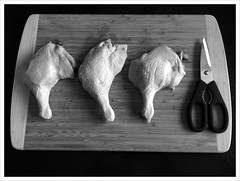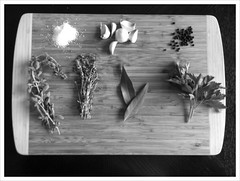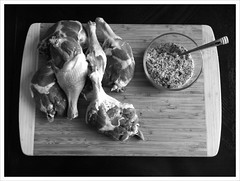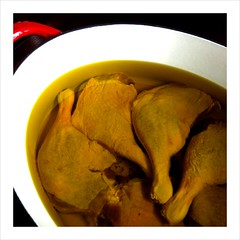As many know, confit is the french preservation method of storing all manner of food items in fat - most notably: duck legs. After my first experience, I have searched for a good source of duck leg in the Dallas area. I came to find out that duck is not really an American food item. It's mostly available during the holiday season but you wont find it in the months between. When it is available at Central Market and Whole Foods it is stupidly expensive.
Enter the Asian markets. Not sure if it was my cultural ignorance or my blind allegiance to Central Market but it never crossed my mind to visit an Asian market. Never. Duck has been a staple in the Asian culture since the beginning of time. When I would go to Asian restaurants I invariably get a duck dish. So why the hell did I never put two and two together - shop at an Asian market, you moron! And that's what I did. Not only did I find legs but I found duck breast, whole ducks, half duck, duck feet, roasting duck and even duck tongue (still haven't figured that one out.)
I visited the two largest, newest stores in the metroplex: 99 Ranch Market and Asia World Market. Both in Plano. Both had a great variety of duck product but I found the legs to be better at Asia World Market. So this past Sunday I picked up two packages of duck leg (6 legs total). I finally got my legs!
Now that I have the legs, the other key ingredient is rendered duck fat; another item that is not readily available. In a search for alternatives I found a recipe by Micheal Ruhlman, pre-eminent food writer and cookbook author (Think French Laundry), which called for olive oil instead of duck fat.
In deciding out to cook these beautiful legs, I combined Bouchon's recipe with Ruhlman's. I used Bouchon's Green Salt for the marinade/cure and the olive oil technique from Ruhlman.
First Step: Preparation




The whole idea of Duck Confit sounds fancy and hard but in reality it's possibly the easiest recipe to make. It has three easy steps: cure, cook, and cool. That's it. The flavor variation comes from two sources: the curing marinade and the braising liquid.
The curing marinade can be a simple mixture of herbs and salt or one that includes coriander, juniper berries, oregano, and such. The possibilities are endless but the most important ingredient is salt.
The braising liquid is traditionally rendered duck fat which imparts the most flavor but substitutions can be made with olive oil (as in this case).


Duck Confit
6 Duck legs; trimmed of excess fat
Olive Oil, enough to fully emerge (I used most of a 2 quart jug)
Green Salt:
1/2 C kosher salt
2 bay Leaves, torn in pieces
1/4 C packed Italian parsley
2 Tbl chopped thyme
Extra:
4 thyme sprigs
4 oregano sprigs
4-9 garlic cloves, peeled
Cure: Combine Green Salt mixture into food processor and blend until mixture is fully combined. Rinse trimmed legs with cold water and pat dry with a paper towel. Pat with Green Salt mixture - typically 1 tablespoon per leg. Be careful not to over salt. Place salted legs in a glass baking dish skin side down. Toss extra thyme, oregano, and cloves on top. Cover with cling wrap and refrigerate 24 hours.
Cook: Preheat oven to 180 degrees. Rinse each leg of Green Salt and dry thoroughly with a paper towel. Place legs skin side up in a single layer in an earthenware dish (may need to double layer, but no more than two legs deep). Pour olive oil evenly over legs with about 1 inch coverage. Cover and place in oven for 10-12 hours.

Cool: To test, stick a fork or tooth pick into a leg. The fork should penetrate the meat with no resistance. Once done, remove dish from oven and transfer legs to a large storage bowl. Strain the olive oil over the legs until the legs are fully submerged. The legs can be kept in this manner for 3-4 months. If you plan on storing the legs for awhile, I'd suggest storing them in pairs. That way you don't have to reheat all of them at the same time.
Note: I was expecting the olive oil to completely harden but it was still a liquid after two days. On the third day in the fridge it finally hardened.
Serve: Fill a large skillet with a few inches of water and heat on low. Place the bowl with the legs in the skillet. Let sit for 20-30 minutes while the olive oil fully melts. Remove legs carefully. Heat a grill pan on med-high heat. Once the pan is ready place the legs skin side down and cook until the skin is crispy. There is no need to use oil sense there is plenty already on the legs. Also, don't turn the legs over. The meat was already re-heated when the olive oil melted. Plate a crisped leg over a simple frisee salad.
This is probably the purest way to enjoy duck confit but there are endless posibilities. You can shred the meat and use it in ravioli, grilled cheese, or a taco. You can make rilletes for an appetizer. However, for my money, a whole leg and a simple salad are enough for me.